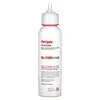What's inside
What's inside
 Key Ingredients
Key Ingredients

 Benefits
Benefits

 Concerns
Concerns

 Ingredients Side-by-side
Ingredients Side-by-side

Water
Skin ConditioningOnsen-Sui
Dipropylene Glycol
HumectantCaprylic/Capric Triglyceride
MaskingCetearyl Alcohol
EmollientCetyl Alcohol
EmollientStearyl Alcohol
EmollientBrassicamidopropyl Dimethylamine
Skin ConditioningBehentrimonium Chloride
PreservativeBehentrimonium Methosulfate
Parfum
MaskingBehenyl Alcohol
EmollientGlyceryl Stearate
EmollientSteartrimonium Chloride
PreservativeQuaternium-33
Alcohol
AntimicrobialPentylene Glycol
Skin ConditioningPropylene Glycol
HumectantIsopropyl Myristate
EmollientPanthenol
Skin ConditioningPropanediol
SolventZinc Pyrithione
AntiseborrhoeicCitric Acid
BufferingButylene Glycol
HumectantSalicylic Acid
MaskingMenthol
MaskingPolyquaternium-10
Guar Hydroxypropyltrimonium Chloride
Skin ConditioningCaprylyl Glycol
EmollientLanolin Acid
CleansingEthylhexylglycerin
Skin ConditioningDisodium EDTA
Laurdimonium Hydroxypropyl Hydrolyzed Wheat Protein
Cnidium Officinale Rhizome Extract
Skin ConditioningPanax Ginseng Root Extract
EmollientSodium Citrate
BufferingHydrolyzed Soy Protein
HumectantHydrolyzed Keratin
HumectantZinc Chloride
AntimicrobialSorbitol
HumectantBelamcanda Chinensis Root Extract
Skin ConditioningSwertia Japonica Extract
Skin ConditioningGlycerin
HumectantCocos Nucifera Oil
MaskingGardenia Taitensis Flower
Skin ConditioningHydrolyzed Rye Phytoplacenta Extract
Skin ConditioningGlycine
BufferingPaeonia Suffruticosa Root Extract
Skin ProtectingSerine
MaskingGlutamic Acid
HumectantNymphaea Alba Flower Extract
Skin ConditioningSerenoa Serrulata Fruit Extract
Skin ConditioningHibiscus Sabdariffa Flower Extract
Skin ConditioningAspartic Acid
MaskingLeucine
Skin ConditioningFagraea Berteroana Flower Extract
Skin ConditioningCananga Odorata Flower Extract
PerfumingAlanine
MaskingLysine
Skin ConditioningArginine
MaskingTyrosine
MaskingPhenylalanine
MaskingUrea
BufferingLecithin
EmollientPolysorbate 80
EmulsifyingThreonine
Proline
Skin ConditioningValine
MaskingIsoleucine
Skin Conditioning1,2-Hexanediol
Skin ConditioningCeramide NP
Skin ConditioningHistidine
HumectantMethionine
Skin ConditioningCysteine
AntioxidantCysteic Acid
Skin ConditioningSodium Succinate
BufferingPlumeria Alba Flower Extract
Skin ConditioningPlumeria Rubra Flower Extract
Skin ConditioningBiotin
AntiseborrhoeicTocopherol
AntioxidantWater, Onsen-Sui, Dipropylene Glycol, Caprylic/Capric Triglyceride, Cetearyl Alcohol, Cetyl Alcohol, Stearyl Alcohol, Brassicamidopropyl Dimethylamine, Behentrimonium Chloride, Behentrimonium Methosulfate, Parfum, Behenyl Alcohol, Glyceryl Stearate, Steartrimonium Chloride, Quaternium-33, Alcohol, Pentylene Glycol, Propylene Glycol, Isopropyl Myristate, Panthenol, Propanediol, Zinc Pyrithione, Citric Acid, Butylene Glycol, Salicylic Acid, Menthol, Polyquaternium-10, Guar Hydroxypropyltrimonium Chloride, Caprylyl Glycol, Lanolin Acid, Ethylhexylglycerin, Disodium EDTA, Laurdimonium Hydroxypropyl Hydrolyzed Wheat Protein, Cnidium Officinale Rhizome Extract, Panax Ginseng Root Extract, Sodium Citrate, Hydrolyzed Soy Protein, Hydrolyzed Keratin, Zinc Chloride, Sorbitol, Belamcanda Chinensis Root Extract, Swertia Japonica Extract, Glycerin, Cocos Nucifera Oil, Gardenia Taitensis Flower, Hydrolyzed Rye Phytoplacenta Extract, Glycine, Paeonia Suffruticosa Root Extract, Serine, Glutamic Acid, Nymphaea Alba Flower Extract, Serenoa Serrulata Fruit Extract, Hibiscus Sabdariffa Flower Extract, Aspartic Acid, Leucine, Fagraea Berteroana Flower Extract, Cananga Odorata Flower Extract, Alanine, Lysine, Arginine, Tyrosine, Phenylalanine, Urea, Lecithin, Polysorbate 80, Threonine, Proline, Valine, Isoleucine, 1,2-Hexanediol, Ceramide NP, Histidine, Methionine, Cysteine, Cysteic Acid, Sodium Succinate, Plumeria Alba Flower Extract, Plumeria Rubra Flower Extract, Biotin, Tocopherol
Ingredients Explained
These ingredients are found in both products.
Ingredients higher up in an ingredient list are typically present in a larger amount.
Parfum is a catch-all term for an ingredient or more that is used to give a scent to products.
Also called "fragrance", this ingredient can be a blend of hundreds of chemicals or plant oils. This means every product with "fragrance" or "parfum" in the ingredients list is a different mixture.
For instance, Habanolide is a proprietary trade name for a specific aroma chemical. When used as a fragrance ingredient in cosmetics, most aroma chemicals fall under the broad labeling category of “FRAGRANCE” or “PARFUM” according to EU and US regulations.
The term 'parfum' or 'fragrance' is not regulated in many countries. In many cases, it is up to the brand to define this term.
For instance, many brands choose to label themselves as "fragrance-free" because they are not using synthetic fragrances. However, their products may still contain ingredients such as essential oils that are considered a fragrance by INCI standards.
One example is Calendula flower extract. Calendula is an essential oil that still imparts a scent or 'fragrance'.
Depending on the blend, the ingredients in the mixture can cause allergies and sensitivities on the skin. Some ingredients that are known EU allergens include linalool and citronellol.
Parfum can also be used to mask or cover an unpleasant scent.
The bottom line is: not all fragrances/parfum/ingredients are created equally. If you are worried about fragrances, we recommend taking a closer look at an ingredient. And of course, we always recommend speaking with a professional.
Learn more about ParfumWater. It's the most common cosmetic ingredient of all. You'll usually see it at the top of ingredient lists, meaning that it makes up the largest part of the product.
So why is it so popular? Water most often acts as a solvent - this means that it helps dissolve other ingredients into the formulation.
You'll also recognize water as that liquid we all need to stay alive. If you see this, drink a glass of water. Stay hydrated!
Learn more about Water